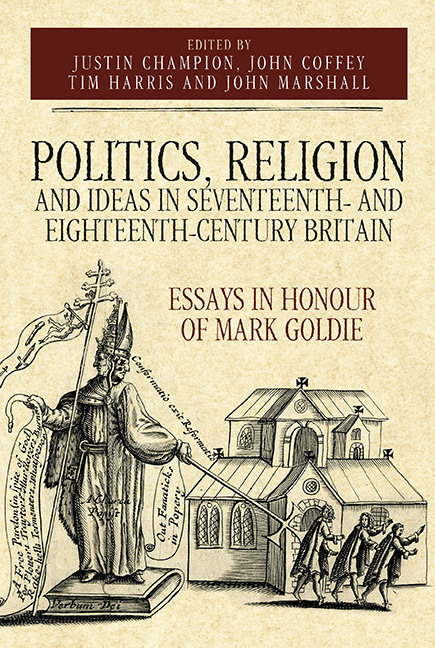 Politics, Religion and Ideas in Seventeenth- and Eighteenth-Century Britain
Politics, Religion and Ideas in Seventeenth- and Eighteenth-Century Britain Published online by Cambridge University Press: 12 October 2019
The assassination of James Sharp, archbishop of St Andrews, took place in 1679, towards the tail end (or perhaps the climax) of the religious violence which followed in the wake of the Reformation. It is to godly assassinations what Salem is to witch-hunts. Reformation Europe had witnessed a series of such killings. In Scotland, Protestant militants slew Cardinal Beaton in the castle of St Andrews in 1546. But it was the late sixteenth century that truly ushered in ‘the Age of Assassination’. A Catholic extremist killed William of Orange in 1584; Jacques Clément of the Catholic League assassinated Henri III of France in 1589; François Ravaillac took the life of Henri IV of France in 1610; and John Felton, a disaffected soldier, stabbed the Duke of Buckingham to death in 1628. As Colin Kidd observes, these assassins became ‘household names’, posthumously honoured with ‘a kind of celebrity martyrdom’. Roland Mousnier's classic study The Assassination of Henry IV explored the contexts of Ravaillac's act, including theories of tyrannicide. On a smaller scale, this essay offers an account of how government policy and radical Covenanter ideology conspired to produce assassins. It examines the textual sources that inspired the insurgents, and the textual responses to their bloody deed.
Despite its notoriety, Sharp's assassination and its ideological context have received relatively little historical scrutiny. Scottish historians, reacting against polarised confessional perspectives, have been inclined to shift the focus away from extremists and martyrs towards the mainstream. Julia Buckroyd's biography of Sharp did include a chapter on the murder, but understandably focused on the archbishop rather than on militant Covenanters. Colin Kidd, by contrast, has traced the Scottish debate over ‘assassination principles’ from George Buchanan to James Hogg. This essay builds on these earlier accounts, paying closer attention to the men who ambushed Sharp on Magus Muir, and to James Mitchell, who narrowly failed to kill the archbishop in 1668. It confirms Mark Goldie's observation that while ‘Restoration England was a persecuting society’, Scotland's regime and its religious dissenters were marked by ‘greater extremity’ than their English counterparts. In the Scotland of the 1660s and 1670s, populist resistance theorists produced ‘the most radical utterances of the time’, inspiring armed uprisings and godly assassins who were countered by an absolutist state using brutal repression and judicial torture.
To save this book to your Kindle, first ensure no-reply@cambridge.org is added to your Approved Personal Document E-mail List under your Personal Document Settings on the Manage Your Content and Devices page of your Amazon account. Then enter the ‘name’ part of your Kindle email address below. Find out more about saving to your Kindle.
Note you can select to save to either the @free.kindle.com or @kindle.com variations. ‘@free.kindle.com’ emails are free but can only be saved to your device when it is connected to wi-fi. ‘@kindle.com’ emails can be delivered even when you are not connected to wi-fi, but note that service fees apply.
Find out more about the Kindle Personal Document Service.
To save content items to your account, please confirm that you agree to abide by our usage policies. If this is the first time you use this feature, you will be asked to authorise Cambridge Core to connect with your account. Find out more about saving content to Dropbox.
To save content items to your account, please confirm that you agree to abide by our usage policies. If this is the first time you use this feature, you will be asked to authorise Cambridge Core to connect with your account. Find out more about saving content to Google Drive.